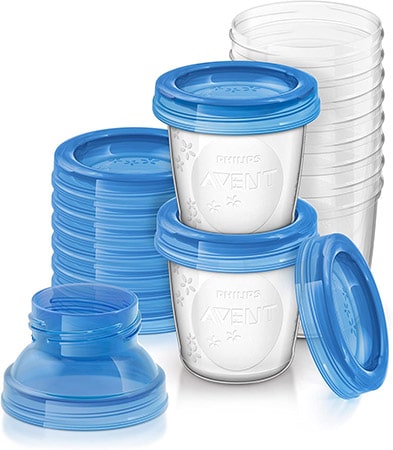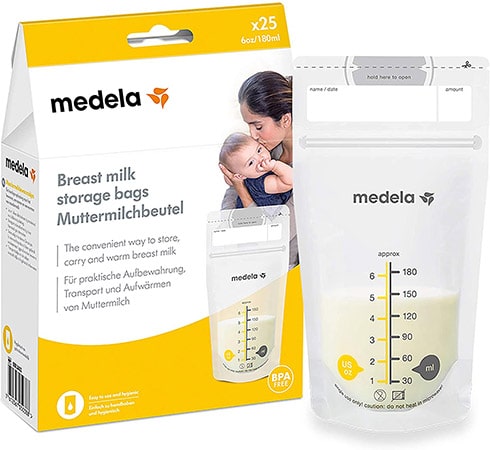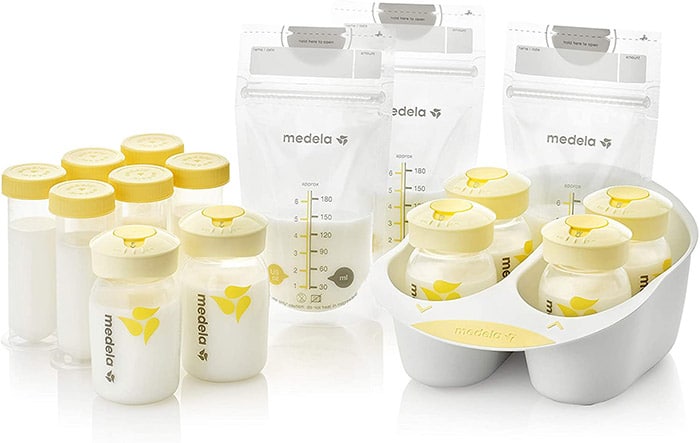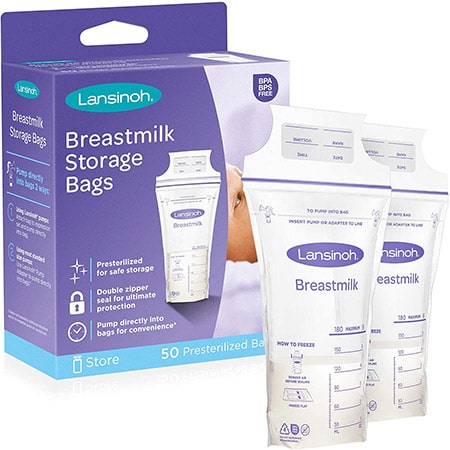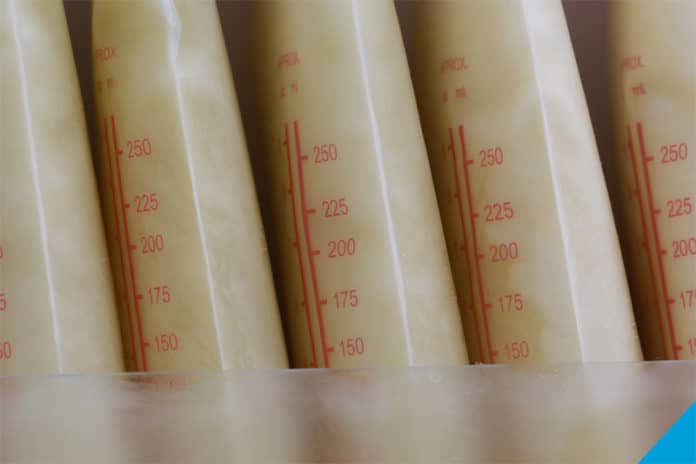
Expressed breast milk, or EBM, is often called “liquid gold” amongst midwives, because it has all the excellent health benefits of breast milk like your antibodies, hormones, beneficial bacteria, and fatty acids to promote fast developmental growth that are hard to replicate synthetically.
Storing your own breast milk for your baby’s later feeds means you keep all these benefits, without needing to be permanently attached. Babies are more efficient than pumps at fully draining the breast, so storing breastmilk is also a great strategy to build up supply in the early days. Pumping half a breast before feeding means your supply will be ahead of demand and there will always be some spare around if your baby has an extra-ravenous day.
How to Store Expressed Breast Milk
Breast milk only keeps those great health benefits if stored hygienically and kept in the best conditions. Here’s a quick rundown of the step-by-step process to store and use expressed breast milk, in its most basic form.
To store:
- Express breast milk with a clean electric pump, manual pump, or by hand, into a clean baby bottle or container.
- Write a label with the date and time you started pumping.
- Label the baby bottle or freezer-safe storage bag
- If the milk will be used later today or tomorrow, fridge the baby bottle directly in the coldest section of your refrigerator.
- If the milk will not be used in the next couple of days, transfer the milk from the bottle into the storage bag and seal tightly
- Freeze the storage bag in the coldest section of your freezer or deep freeze chest.
To use:
- If frozen, defrost breast milk in the fridge for 12 hours, or in a few minutes under warm running water.
- Gently swirl breast milk to make a consistent temperature and mix separated fats.
- Discard any used storage bags.
- After feeding your baby, discard any breast milk that has previously been frozen.
Breastmilk shelf life table
Breast Milk | Room Temp | Refrigerator | Freezer | Deep Freeze |
|---|---|---|---|---|
Freshly expressed into closed container | Varies, ~6 hours | 72 hours | 3 months | 12 months |
Previously frozen, thawed in fridge | Varies, ~4 hours | 24 hours | Never refreeze thawed milk | Never refreeze thawed milk |
Thawed outside fridge | For immediate feeding. Do not reoffer, discard all leftovers. | Varies, ~4 hours | Never refreeze thawed milk | Never refreeze thawed milk |
How long can breast milk stay at room temperature?
As short a time as possible, really only for baby’s next feed. It can be tempting to leave freshly pumped milk on the counter if your baby prefers it warm, but warmer milk spoils faster.
The 6 hours for fresh milk and 4 hours for thawed milk can vary greatly with temperature, humidity, the cleanliness of your equipment, and other factors that are hard to control for.
The best practice is to never have milk outside the refrigerator or freezer, except during thawing and feeding.
How long does breast milk last in the fridge?
72 hours from pumping, or 24 hours if it’s come straight from the freezer. Unless you have more supply than baby demands, you will usually put breast milk straight into the fridge after expressing.
To keep the milk at its best, always store it in the coldest section of the fridge, which is usually at the back, nearest the freezer section.
How long does breast milk last in the freezer?
With frozen breast milk, the colder the freezer, the longer it lasts. For the standard refrigerator with two doors, one for the fridge section and one for the freezer section, milk should last 3 months at -18°C.
However, some fridges don’t have a separate freezer section, and instead have a small freezer compartment in the top of the fridge. These don’t get as cold, and milk stored here should be kept no longer than 2 weeks.
Some people have a deep freeze, a free-standing freezer chest that keeps under -20°C, and this can hold milk for 12 months. The length of time completely depends on the temperature, so check your veggies haven’t bumped your freezer’s temperature controls every so often.
Labelling breast milk
In your tiredest and most bleary eyed state, it can sometimes be all you can manage just to pump at all. But without a label, if you ever have more than one bag or bottle of milk in the refrigerator you will fast forget when you pumped.
Most freezer bags have a special area for you to write with a pen the time and date you pumped, but unfortunately even permanent marker ink does not do well in the freezer over several weeks. Baby bottles can be marked with whiteboard markers, which smudges when touched.
The easiest thing to do is buy a roll of regular office stationery labels, and keep them with a felt tip pen in your pumping equipment. Even this is not fully smudge proof in an environment with condensation, so optimise future readability by writing the full month between the day and time, no year, and only write “pm” for afternoon and blank for morning. This way, “3X Apxxl 1X:00xm” still gives you more usable information than “3X/0XX2X 1X:00xm”. Don’t forget to write your child’s name if the milk is going to day care!
Defrosting breast milk
If you’re freezing and thawing breast milk, there are two easy ways to defrost your milk, one for tomorrow, and one for right now.
- For tomorrow: simply put your frozen milk in the fridge. It’ll take about 12 hours to defrost, but will easily last all next day.
- For right now: run some warm water over the packet for a few minutes. This does not waste as much water as you might think! If you put a plug in the sink, you can see this really only amounts to a few cups. You can also sit the milk packet in warm water, but this takes longer, and you may need to change the water a few times.
Never leave breast milk to defrost on the counter at room temperature, as the outside of the milk will begin to spoil before the insides have thawed.
There are also bottle warmers out there, but testing has found that most of these overheat the milk past 40ºC, destroying some of the nutritious proteins and risking burns to the baby’s oesophagus.
Can I defrost breast milk in the microwave? Or a bottle warmer?
Official advice says you should not defrost milk in the microwave because microwaves heat unevenly, creating hot spots that can scald babies and destroy nutrients in the milk. The reason for this is that breast milk above 40ºC is being “cooked” rather than “warmed”.
There is no evidence to suggest that microwaving breast milk under 40ºC is harmful, as long as the milk is stirred and left to stand to avoid hot spots, but it would be very difficult to be sure of the temperature of milk inside your microwave, so it’s not recommended.
Electric bottle warmers are not recommended for the same reason, although they do heat evenly without hot spots. If you use one, start with the lowest setting and creep upwards to ensure no overheating. At these lower settings, you may find that running the bag under the warm tap is simply faster.
Can babies have cold breast milk?
They can! But many babies don’t like it, because they know and love your warm body-temperature breast milk. At cold temperatures, the fats in the breast milk separate, creating a “bitsy” texture, also separating the sweet lactose from the non-sweet fat.
This does not change the quality of your breast milk, and in fact, avoids the potential quality reduction of overheating it. If you’ve ever had a bar of chocolate that’s melted in the sun and then rehardened in the fridge, it’s a comparable experience of that strange, “separated” texture and taste.
Swirling the milk around for a minute can help re-mix the fats and smoothen the texture, and your warm hands on the bottle can help, too. Of course, babies get used to cold milk, and even frozen breast milk cubes can be a great treat in summer, or for teething!
If you’re keen for the convenience of not having to warm the milk each time, slowly decreasing the warmth of the milk with each bottle feed is a gentle way to adapt fussy babies to different temperatures.
Is breastfeeding better for babies than expressing and storing?
If expressed breast milk is handled gently and not cooked, the only advantage to breastfeeding is that your baby is more efficient at draining the entire breast than any pump ever invented.
Sometimes mum and baby can’t always be together in the same place, if one of them is still in the hospital, or if mum needs to return to work. Bottle feeding is also a great way for dads to get some bonding time with the new baby, and give mums a little much-needed extra sleep.
Sometimes your baby can have trouble latching or sucking for a while, and pumping is great for helping to compensate for their low demand. Once the baby is suckling, they only have two weeks, four at very most, to “train” your breasts to supply the full amount they’ll be drinking for the rest of their breastfeeding.
After that critical period, it’s possible to reduce supply, but very difficult to increase it. Premature babies especially are too tiny to drink enough to build up that supply, and make pumping milk an absolute necessity for the first several weeks.
Breast milk storage solutions
Keeping milk in a baby bottle is fine for a single extra feed in the fridge, but multiple bottles will quickly take up a whole shelf, and won’t be usable for feeds while in storage. The usual way to store your surplus milk is in a storage bag that can lie flat to save space, self stand for pouring, and won’t leak on its side.
Good breast milk storage bags are freezer safe, BPA and BPS free, and can be hygienically discarded after use. Many online reviews may complain that the markings are wildly inaccurate, but that’s the drawback of a flexible container, they cannot be relied on for accurate measurements. If volume measurement is important, a firm freezer safe container is a good alternative, that can often be washed and reused, too.
Here are our top recommendations for breast milk storage solutions currently available.
1. Baby Chan Breast Milk Storage Bags
Price AUD: Loading ...
These simple storage bags are the best shape for a variety of ways to store. They lie fairly flat in a stack backlogged frozen bags, they stand up on the counter to prepare the bottle, and despite the low bulk-buy price, they’re strongly sealed with double zipper seal and reinforced side seal.
But best of all, they have a handy spout at the side, so you can pour the milk out from a clean cut, rather than messily pour the contents over the double zipper. They’re only available as a pack of 100, but it’s a value buy for a product so practical to use.
2. Philips Avent Breast Milk Storage Containers with Lids
Price AUD: Loading ...
If disposable plastic bags seem too wasteful for you, these BPA-free containers are reusable, microwave and dishwasher safe, and conveniently shaped to stack like cups, taking up less room in your home and less waste in the environment.
They also have the benefit of being a non-flexible container, so the measurement markings up the side are far more reliable than on storage bags. This package of ten also comes with convenient adaptors that can convert the cup to attach directly to your breast pump, or even into a baby bottle that can take a regular Avent nipple.
You do have to be quite careful with screwing on the lid that it doesn’t sit at an angle, or else it can leak. However, the lids stack as well as the cups, and continue to fit well despite microwaving and dishwashing. You may see further use with pureed baby food and other snacks, after your baby is weaned!
3. Medela Breast Milk Storage Bags
Price AUD: Loading ...
These simple and strong storage bags often seem to be on sale, and once you’ve been through a few packets, the price ends up being the sales feature that counts! The bags are designed to stand with a flare or be laid flat, and they are remarkably strongly sealed for flat storage.
The shape of the bags is fairly slender, so they’re better at flattening than others, and also will thaw and warm faster. These storage bags feature a leak proof double zipper seal, double wall for strength, and large writing area for labelling.
4. Medela Breast Milk Storage Solutions Set
Price AUD: Loading ...
If you don’t already have your baby bottles and pumping equipment set up, this value starter set is a great way to make sure you have everything you need with your first pump.
This system includes 6 baby bottles, 6 labelling lids, 6 breast milk storage tubes, 20 breast milk storage bags, and an organising tray to keep your milk in order in the fridge.
The labelling lids are a genius idea we’d like to see more of, because you can twist the lid around to which day and time you pumped the milk. This only accounts for Monday to Sunday, so it won’t work for freezing long term, but for fridge use this is far easier than making a label every time.
The storage tubes are great for mums new to breastfeeding, as they safely store up to 80mLs of breast milk in a small space. New mums attempting to increase supply appreciate the clear indicators for small volumes, and the smaller container means less wastage of small amounts of milk.
5. Unimom Premium 240ml Breast Milk Storage Bags
Price AUD: Loading ...
If you have twins or an oversupply of milk, the standard 180mL bags never seem to quite cut it! These extra large storage bags contain up to a full metric cup of breast milk, so you won’t have to waste another bag on the “leftovers” again.
Another great feature of these bags is the thoughtful design to have a perforated edge that tears easily to open along the top, removing the need to keep dangerous scissors near your pumping gear.
The walls are thick and sturdy making these bags extremely durable and allowing them to stand solidly, with less chance of spills. There’s also a printed guide down the side of the bags, with the appropriate shelf life for breast milk at room temperature, refrigerated and frozen, which is helpful for anyone on babysitting duty.
6. Lansinoh Breastmilk Storage Bags
Price AUD: Loading ...
These simple bags are the standard to go to when you first start pumping, and many mums find they stick with them through the whole breastfeeding stage. These bags are compatible with many brands of pump, thanks to two handy adaptors that plug straight into the bags, so you won’t have to wash an extra container every time you express.
Strong, sturdy, and inexpensive, these bags are easy to use and have plenty of useful information for beginners printed on the bag cover where you’ll never lose it. As well as markers to indicate estimated volume, there is marked label space for the time, date, volume, and baby’s name, which makes milk easy to keep track of and reduces the risk of information lost to smudging.
7. Tommee Tippee Express And Go Starter Kit
Price AUD: Loading ...
This starter kit is a really great gift for new mums, because it removes a decent chunk of the work involved with pumping and feeding, albeit for a higher price. The breast pump adaptor fits to the major pumps: Medela, Lansinoh, Ameda, Avent, and Tommee Tippee, and screws directly into the neck of the bag without leaking.
You won’t have to wash the container you pump into, because after twisting off, the strong bags are immediately ready to be laid flat in the fridge or freezer. Once your baby is ready to eat, the bag comes out and can self-stand while you screw on the Tommee Tippee slow flow nipple.
The included nipple is popular with babies for its round shape and mums for its slow feed that helps avoid spit ups. Although they’re the priciest, these bags are definitely the most convenient, cutting down on multiple washes and used storage.


